Major Debate
Federalists vs. Anti-Federalists
DEBATE: Nationalism vs. Rights of Individuals?
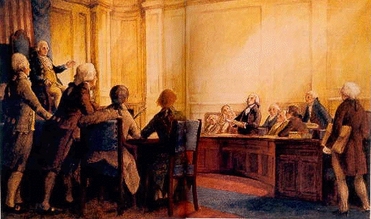
The major debate between the 55 colonial delegates during the Constitutional Convention of 1787 was whether to revise the Articles of Confederation or to create a whole new Constitution and give the central or federal government more power to tax and regulate commerce. Two sides that emerged to argue whether the new government should have more power were the Federalist and the Anti-Federalist.These two groups of state delegates also emerged with opposing views on whether the newly proposed Constitution asserted rights and privileges for each of their states and fellow countrymen.
FEDERALISTS
- Favored ratification of the new Constitution
- Favored a powerful federal government
- Argued the Bill of Rights was not needed, as federal powers were limited
- Wrote propaganda essays called the "Federalists Papers"
- A large republic was
seen as the best
protection for
individual freedoms - Consisted of Land Owners, Large Farmers,
Merchants, and Artisans
ANTI-FEDERALISTS
- Opposed ratification of the new Constitution
- Wanted a weak federal government that would not threaten states' rights
- Wanted a Bill of Rights to declare & protect the rights of the people.
- Strongly supported power
and influence of states and local government - Believed only a small republic
could protect rights - Consisted of Small farmers, often
from rural areas
DIPLOMACY: We will add the Bill of Rights to the Constitution...
The Bill of Rights became the bargaining chip for the Anti-Federalists as they made sure that the public was aware that any form of government had to be careful that history was not repeated. They also understood that the government oppression that led Americans to revolt against the British could likely be repeated if they did not ensure the basic human rights of American Citizens.
James Madison who is credited for drafting the Bill of Rights introduced it in 1789. Eventually the Federalists agreed to include the Bill of Rights to the Constitution if that was what the Anti-Federalists needed in order to ratify the Constitution and establish the Federal Government we know today.
The Bill of Rights contained 10 Articles that became known as the first ten amendments or changes to the US Constitution. These include natural human rights such as: right to free speech, right to a speedy trial, freedom of religion, etc...
The Bill of Rights was influenced by English Bill of Rights, different works during the Enlightenment Period, as well as the Magna Carta. To this day the Bill of Rights serves to define and protect our rights as citizens.
The Bill of Rights became the bargaining chip for the Anti-Federalists as they made sure that the public was aware that any form of government had to be careful that history was not repeated. They also understood that the government oppression that led Americans to revolt against the British could likely be repeated if they did not ensure the basic human rights of American Citizens.
James Madison who is credited for drafting the Bill of Rights introduced it in 1789. Eventually the Federalists agreed to include the Bill of Rights to the Constitution if that was what the Anti-Federalists needed in order to ratify the Constitution and establish the Federal Government we know today.
The Bill of Rights contained 10 Articles that became known as the first ten amendments or changes to the US Constitution. These include natural human rights such as: right to free speech, right to a speedy trial, freedom of religion, etc...
The Bill of Rights was influenced by English Bill of Rights, different works during the Enlightenment Period, as well as the Magna Carta. To this day the Bill of Rights serves to define and protect our rights as citizens.
FEDERALIST vs. ANTI_FEDERALISTS
Documentary
Narration: "..the Federalists were in favor of ratification of the constitution and the Anti-Federalists were against the ratification because they felt that the Central Government would be too strong and there wouldn't be enough individual rights and states rights protected. Furthermore, they feared that these two factors would ultimately lead their government down the path of monarchy. Eventually to appease everyone a compromise was forged. The Bill of Rights would be added if the Anti-Federalists would ratify the Constitution. Thomas Jefferson and Patrick Henry were two of the leading Anti-Federalist. "It has proved itself" as Franklin Roosevelt once said "to be a marvelously elastic compilation of rules of government ever written"
Documentary
Narration: "..the Federalists were in favor of ratification of the constitution and the Anti-Federalists were against the ratification because they felt that the Central Government would be too strong and there wouldn't be enough individual rights and states rights protected. Furthermore, they feared that these two factors would ultimately lead their government down the path of monarchy. Eventually to appease everyone a compromise was forged. The Bill of Rights would be added if the Anti-Federalists would ratify the Constitution. Thomas Jefferson and Patrick Henry were two of the leading Anti-Federalist. "It has proved itself" as Franklin Roosevelt once said "to be a marvelously elastic compilation of rules of government ever written"
to view this video on www.youtube.com: click here
Major Debate
Large States vs. Small States
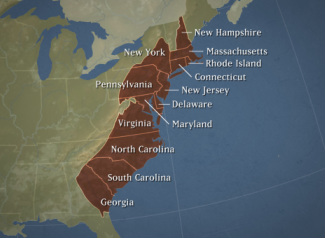
DEBATE: Equal representation vs. Representation based on population
One of the first issues that came up during the Constitutional Convention was how the American people would be represented in the United States Congress. The United States Congress would have the power to tax and regulate commerce so states wanted their voice to be fairly represented in this process. Two very different plans were submitted on how states were to be represented in the US Congress which were called: the Virginia Plan, and the New Jersey Plan, Delegate Edmund Randolph from Virginia, a state with a large population, offered a plan that would allow representation in the House of Congress and House of Senate to be proportionally based on the population of each state. Hence, this became known as the Virginia Plan.
On the other hand, delegate William Patterson from a smaller state like New Jersey, offered a counter plan which called for each state to have the same number of representatives in a unicameral legislature. This would give states an equal vote in the US Congress. Smaller states feared that they would have larger states would have more influence in the new government if the Virginia Plan was approved. Suffice it to say both large states and small states had opposed each others plan on representation to the United States Congress and diplomacy was needed.
One of the first issues that came up during the Constitutional Convention was how the American people would be represented in the United States Congress. The United States Congress would have the power to tax and regulate commerce so states wanted their voice to be fairly represented in this process. Two very different plans were submitted on how states were to be represented in the US Congress which were called: the Virginia Plan, and the New Jersey Plan, Delegate Edmund Randolph from Virginia, a state with a large population, offered a plan that would allow representation in the House of Congress and House of Senate to be proportionally based on the population of each state. Hence, this became known as the Virginia Plan.
On the other hand, delegate William Patterson from a smaller state like New Jersey, offered a counter plan which called for each state to have the same number of representatives in a unicameral legislature. This would give states an equal vote in the US Congress. Smaller states feared that they would have larger states would have more influence in the new government if the Virginia Plan was approved. Suffice it to say both large states and small states had opposed each others plan on representation to the United States Congress and diplomacy was needed.
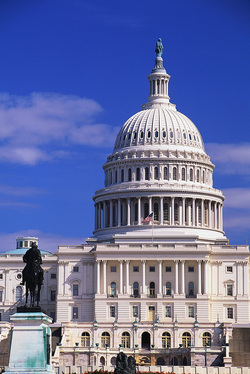
DIPLOMACY:Lets satisfy the needs of both large states and small states ...
To help solve the debate a diplomatic compromise was crafted by the delegates Roger Sherman and Oliver Ellsworth from Connecticut, which was called the Connecticut Plan. This diplomatic compromise proposed a two-house congress or Bicameral Legislature made up of a House of Senate and a House of Representatives, whereas each state, would send two senators to the House of Senate to give smaller and larger states an equal vote, and send one Representative to the House of Representatives for every 30,000 residents of the state. This gave larger states a greater influence in this house. This compromise satisfied the needs of both larger and smaller states and became known as the Great Compromise it was debated for eleven days and finally ratified on July 16 1787 by one vote (7 to 6).
To help solve the debate a diplomatic compromise was crafted by the delegates Roger Sherman and Oliver Ellsworth from Connecticut, which was called the Connecticut Plan. This diplomatic compromise proposed a two-house congress or Bicameral Legislature made up of a House of Senate and a House of Representatives, whereas each state, would send two senators to the House of Senate to give smaller and larger states an equal vote, and send one Representative to the House of Representatives for every 30,000 residents of the state. This gave larger states a greater influence in this house. This compromise satisfied the needs of both larger and smaller states and became known as the Great Compromise it was debated for eleven days and finally ratified on July 16 1787 by one vote (7 to 6).
Large States
- Virginia
- Georgia
- North Carolina
- South Carolina
- Pennsylvania
- New York
Small States
- New Hampshire
- Connecticut
- Vermont
- Rhode Island
- Massachusetts
- New Jersey
- Delaware
Major Debate
Citizens vs Property
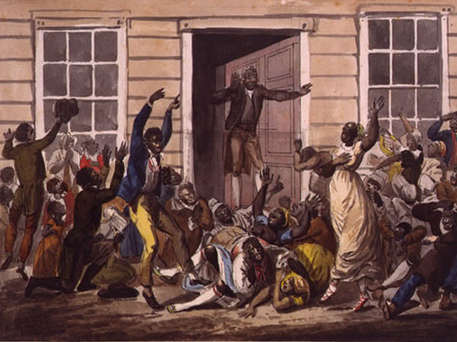
DEBATE: Slaves counted as citizens vs. property.
The second issue, was between the Northern and Southern states. Many Southern State delegates were slave owners and wanted to have the slaves counted in the census. This would increase their population, which would in turn allow the Southern States to send more representatives to the House of Representatives. The North argued that slaves were actually considered by the Southern State Delegates as property and therefore could not be counted as citizens. If they were to be counted as citizens then they would have to be
considered to have rights protected under the Constitution. Of course this was contrary to the view of many white Americans at the time. Slaves were not considered citizens with the same rights as white Americans.
The second issue, was between the Northern and Southern states. Many Southern State delegates were slave owners and wanted to have the slaves counted in the census. This would increase their population, which would in turn allow the Southern States to send more representatives to the House of Representatives. The North argued that slaves were actually considered by the Southern State Delegates as property and therefore could not be counted as citizens. If they were to be counted as citizens then they would have to be
considered to have rights protected under the Constitution. Of course this was contrary to the view of many white Americans at the time. Slaves were not considered citizens with the same rights as white Americans.
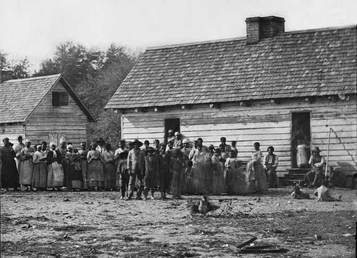
DIPLOMACY: For every 5 slaves 3 votes will be counted...
On June 12th, 1787, it was finally agreed that three-fifth of the slave population of America can be counted as the population of the nation. James Madison and Roger Sherman proposed a compromise which would allow Southern States to count slaves as part of the population. This made the Southern State Delegates very happy, but instead of counting each slave as one citizen they used a ratio 3:5. This meant that for every 5 slaves that were counted it would only give Southern States 3 people to be counted for the census. This satisfied the Northern States who did not want the Southern States to have an unfair advantage in the population count.
On June 12th, 1787, it was finally agreed that three-fifth of the slave population of America can be counted as the population of the nation. James Madison and Roger Sherman proposed a compromise which would allow Southern States to count slaves as part of the population. This made the Southern State Delegates very happy, but instead of counting each slave as one citizen they used a ratio 3:5. This meant that for every 5 slaves that were counted it would only give Southern States 3 people to be counted for the census. This satisfied the Northern States who did not want the Southern States to have an unfair advantage in the population count.